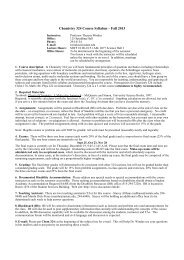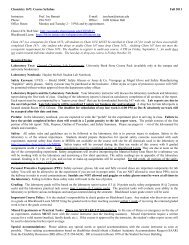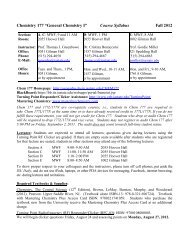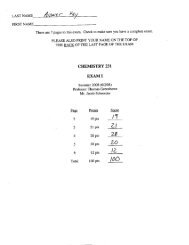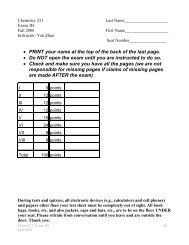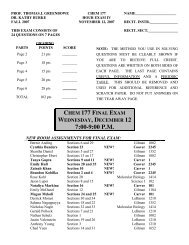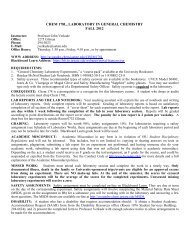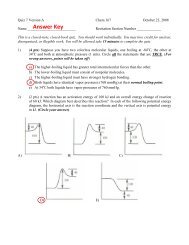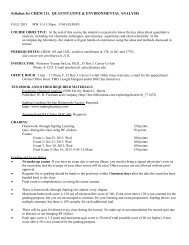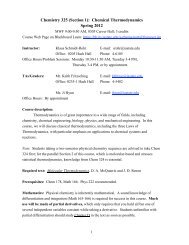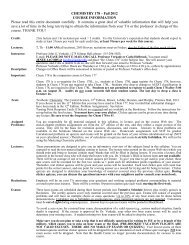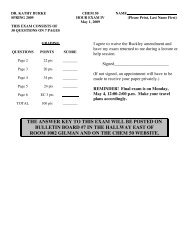Chapter 9 Gases: Their Properties and Behavior 1 of 4 Ch. 9 Gases ...
Chapter 9 Gases: Their Properties and Behavior 1 of 4 Ch. 9 Gases ...
Chapter 9 Gases: Their Properties and Behavior 1 of 4 Ch. 9 Gases ...
Create successful ePaper yourself
Turn your PDF publications into a flip-book with our unique Google optimized e-Paper software.
<strong><strong>Ch</strong>apter</strong> 9 <strong>Gases</strong>: <strong>Their</strong> <strong>Properties</strong> <strong>and</strong> <strong>Behavior</strong> 2 <strong>of</strong> 4V α 1 PV α n TPor V = n TPR => PV = nRT called the “Ideal Gas Equation” (know)where R is called the gas constant; Given on exams: R = 0.08206liter atmmol KExample: What is the volume <strong>of</strong> 1.00 mol <strong>of</strong> gas under st<strong>and</strong>ard state conditions (0 o C, 1 atm)?PV = nRTV = nRTPneed T in K: 0 + 273 = 273 KV = 1.00 mol 0.08206 liter atm mol-1 K -1 273 K1.00 atmcalled the molar volume <strong>of</strong> a gas.All gases, 1 atm, 273 K, 1 mol: occupy 22.4 L= 22.4 LCan use ideal gas equation to calculate changes in variables given new conditions.Example: Suppose that a balloon has a volume <strong>of</strong> 10.2 liters at a pressure <strong>of</strong> 1.00 atm <strong>and</strong> a temperature <strong>of</strong>25.2 o C. The balloon is submerged in water to a depth where the pressure is 1.30 atm. The volume hasdecreased to 7.69 liters. What is the temperature <strong>of</strong> the water.PV = nRT; n, R are constant, so rearrange ideal gas equation to put all constants on one side <strong>and</strong> allvariables on the other.initial conditions:P 1 V 1T 1= nRfinal conditions:P 2 V 2T 2= nR <strong>and</strong>:rearrange to solve for unknown:P 1 V 1T 1= P 2V 2T 2T 2 = P 2V 2 T 1P 1 V 1T 1 = 25.0 + 273.15 = 298.1 5 KT 2 = 1.30 atm x 7.69 l x 298.1 5 o C1 atm x 10.2 l= 292.2 K (19.1 o C)Use units!



